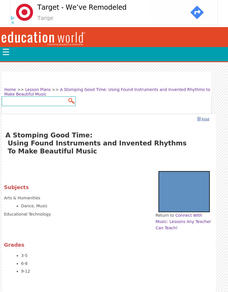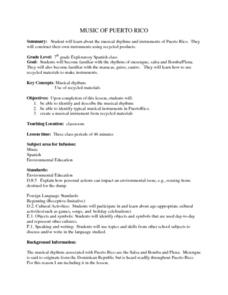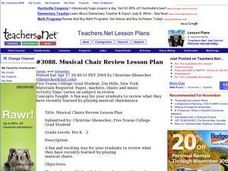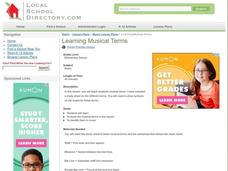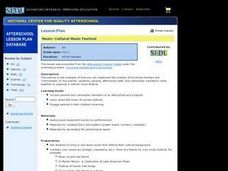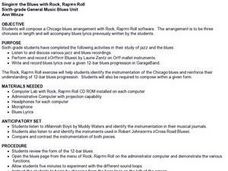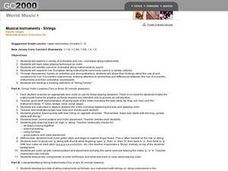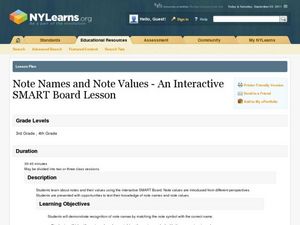Curated OER
Hispanic Arts: Visual Arts, Dance and Music
Students observe global cultures by listening to music and watching videos. In this Latin American dance instructional activity, students define merengue, salsa and other dances from the Hispanic culture while listening to Latin rhythm...
Curated OER
The Impact of Islamic Culture on the Arts of the Renaissance
Eighth graders examine the linguistic and cultural impact of the Arabic language and Islamic culture on the Spanish language. They analyze and label maps, listen to and differentiate between Spanish and Arabic music, and compare and...
Curated OER
Improvising Music
Students watch "The Greatest TV Moments: Sesame Street Music A to Z" and improvise melodic and rhythmic embellishments for the song "O What A Beautiful Morning" or "Rubber Duckie."
Curated OER
A Stomping Good Time: Using Found Instruments and Invented Rhythms to Make Beautiful Music
Students work in small groups to use everyday objects to create performances inspired by the work of STOMP. They create a system of notation to document the music and movement of a 2-minute performance.
Curated OER
Bud, Not Buddy
Fifth graders read the book Bud, Not Buddy and participate in activities that generate understanding of the Great Depression. In this realistic fiction instructional activity, 5th graders read about a boy who grew up during this time....
Curated OER
VH1 AIDS: A Pop Culture History Lesson 2
High schoolers examine messages in popular music, and observe the musical elements of the Rhythm and Blues and Rap genres.
Curated OER
Music of Puerto Rico
Seventh graders study about the musical rhythms and instruments of Puerto Rico. Then they construct their own instruments using recycled products. Students listen to different genres of music and define them. Students focus on the...
Curated OER
Syncopation and Rhythm in Igor Stravinsky's Rite of Spring and Rap Music
Middle schoolers recognize and clap the syncopated rhythmic beat of a rap song and identify recurring rhythmic pattern in the excerpt of "Dance of the Adolescents" from Igor Stravinsky's Rite of Spring.
Curated OER
Musical Chair Review
Students play a simple game designed to reinforce letter names, sounds or sight words. They walk in a circle as music plays, and stop in front of a chair when the music stops. Each chair has a letter or sight word that the child must...
Curated OER
Cave Paintings: Leaving a Message
Fourth graders create cave paintings to leave behind a message for the future civilizations about how they live today.
Curated OER
The Musical Alphabet-Stepping Up
Learners explore the music alphabet. They step up from any letter of the musical alphabet. Students practice stepping up or skipping from various letters within the musical alphabet.
Curated OER
Learning Musical Terms
Young scholars observe and discuss the following musical terms and their symbols: staff, measure, bar line, double bar line, treble clef, bass clef, time signature, common time, cut time, quarter note, half note, dotted half note, whole...
Curated OER
Cultural Music Festival
Students participate in planning a multi-cultural community event. In this cultural music lesson, parents, community members, and teachers provide time, music, advertisement, and refreshments to create a community multi-cultural music...
Curated OER
Moving with Music
Second graders explore and experience the basic concepts of crescendo, decrescendo, andante and allegro by moving with the appropriate signal in accordance to the music being sung. They study the words to the songs "Old McDonald,"...
Alabama Learning Exchange
Musical Patterns
Young scholars explore the concept of patterning using musical instruments. In this music activity, students identify several instruments and practice playing patterns with them. Young scholars identify the patterning in a musical piece.
Curated OER
Activities Using Music From Saint-Saens & Moussorgsky
Student create a fish and listen to music while imagining their fish are swimming. In this music activity, students identify instruments played and move their fish to the movement. Students work with kangaroos and elephants to music...
Curated OER
Signin' the Blues with Rock, Rap 'n Roll
Sixth graders listen to recordings and study jazz and the blues music. They identify the instrumentation and explore the 12-bar blues progression. After experimenting with different sound, 6th graders create their own arrangement, with...
Curated OER
Point of View - Sharing a Perspective on Music
Students share their perspective about music. In this music perspective instructional activity, students complete a music notes handout and watch a segment of a band playing the "St. Louis Blues." Students write a critique of the music...
Curated OER
Musical Instruments - Strings
Students explore various string instruments in this multi-week music lesson for the upper-elementary grades. Emphasis is placed on group violin lessons, listening to and identifying string instruments, and researching non-European...
Curated OER
Note Names and Note Values-An Interactive SMART Board Lesson
Students discuss note names and symbols. In this music lesson, students identify note names and values. Students play a game using the SMART board in which they identify note names and values.
Curated OER
Pop Art Ice Cream Painting
Pupils develop skills in painting and create a painting of an ice cream cone using Pop Art as in inspiration.
Curated OER
Carnival of the Animals and Aquarium and Magic Fish
Engage little learners in this moderately developed three-lesson unit on the composer Camille Saint-Saens and his piece "The Carnival of Animals." Each lesson includes a listening, discussion, and an art project to engage your class in...
Curated OER
Hot, Hot, Hot, Cold
Learners dance the image of falling snow. They move, swing, fall, and rise to music working to depict snow falling, the sun, and high/low movements. This is a well-thought out lesson that aids them in seeing movement as a form of...
Curated OER
Television Newscasts
When we watch news broadcasts on television, we receive a much more visual perspective than when we read the newspaper. How do sets, clothing, and music contribute to our understanding of the story? Compare American and Canadian news...





